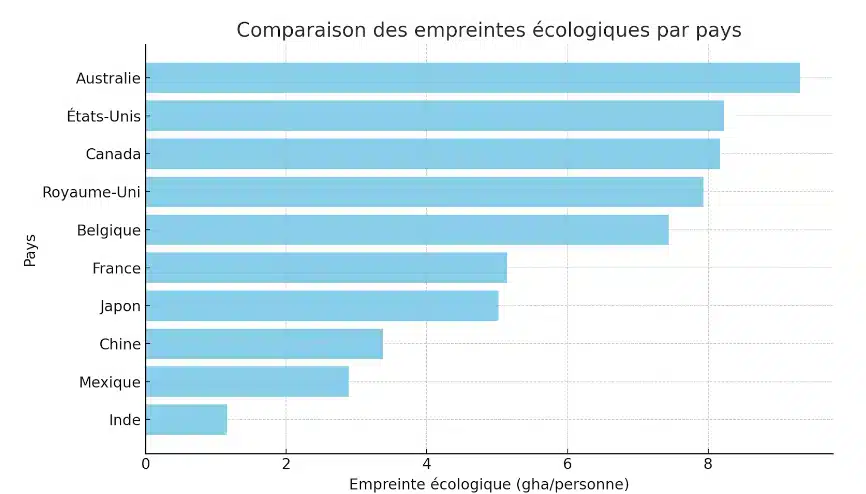
Understanding the ecological footprint
The ecological footprint is an indicator that measures the pressure exerted by human activities on the planet’s ecosystems. it assesses the area required to produce the resources consumed and absorb the waste generated by a person, organization, or population. the main components of the ecological footprint include energy consumption, land use, the carbon footprint (linked to co2 emissions), and waste management.
Calculating the ecological footprint allows us to quantify the environmental impact of our lifestyles and identify areas where improvements can be made. for example, by measuring the ecological footprint, it is possible to assess the sustainability of our eating, transportation, and energy consumption habits, and to implement strategies to reduce our impact on the planet.
Ecological footprint vs. carbon footprint
The ecological footprint and the carbon footprint are two complementary but distinct environmental indicators. the ecological footprint measures the land area required to generate the resources used and assimilate the waste produced by an individual or organization.
The carbon footprint, on the other hand, focuses exclusively on greenhouse gas emissions, primarily co2, generated by human activities. thus, the carbon footprint is a component of the ecological footprint, specifically targeting the climate impacts linked to GHG emissions.
Your free carbon accounting awaits
Answer 20 questions and get yoru first carbon footprint.
The different components of the ecological footprint
The ecological footprint is a global indicator, but it is composed of several distinct categories. these allow us to better understand the origins of our environmental impact.
Carbon footprint
Often the most significant, the carbon footprint measures greenhouse gas emissions linked to our daily activities. it takes into account both direct emissions (such as the use of a personal vehicle) and indirect emissions (for example, the production of a consumer good).
The highest-emitting sectors are transportation, heating, electricity production from fossil fuels, and the manufacturing of goods and services. the carbon footprint is expressed in global hectares (gha). it represents the forest area required to absorb the co2 emissions generated.
Food footprint
The way we eat has a direct impact on the environment. the food footprint takes into account land use for agricultural production, the energy consumed for food processing and transportation, as well as emissions related to livestock farming.
Thus, a diet rich in red meat, processed, or imported products significantly increases the ecological footprint. conversely, a plant-based, local, and seasonal diet can significantly reduce it.
Residential footprint
This component measures the impact of our housing style: home size, insulation, type of heating, water and electricity consumption, use of renewable energy, etc. living in a large, poorly insulated house heated by oil or gas considerably increases the residential footprint. conversely, living in a well-insulated home powered by green energy helps limit its impact.
Transportation footprint
Daily travel and long-distance travel account for a significant portion of our ecological footprint. internal combustion engine cars, air flights, and cruises are particularly polluting. using public transportation, cycling, and carpooling all contribute to reducing this footprint. the frequency of travel and the distance traveled are also determining factors.
Footprint related to the consumption of goods and services
This component of the ecological footprint assesses the impact of the items we purchase (clothing, electronic devices, furniture, etc.) as well as the services we use. the manufacturing, transportation, packaging, and end-of-life of each product consume energy and natural resources. opting for responsible consumption and favoring second-hand, reused, or recycled products helps reduce this portion of the ecological footprint.
Methodology: how is the ecological footprint calculated?
The ecological footprint calculation is based on a scientific method developed by mathis wackernagel and william rees. it converts our human activities into the surface area required to meet our needs and absorb our waste. this method thus provides a concrete measure of our pressure on natural resources.
A common unit: the global hectare (gha)
The global hectare is a standardized unit of measurement that allows for comparison of different forms of resource use. a global hectare corresponds to one hectare of land with average global productivity. this unit allows for the merge of different data (forests, agricultural land, fishing areas, etc.) into a single indicator.
The calculation therefore assesses the area required to:
- Produce the resources we consume (food, wood, fiber, energy, etc.)
- Absorb the waste we generate, particularly co2 emissions
- Housing human infrastructure (roads, housing, industrial zones, etc.)
Data taken into account in the calculation
To determine an individual or collective ecological footprint, several consumption categories are analyzed:
- Food: types of food consumed, origin, processing, waste.
- Energy: sources used for heating, electricity, and appliances.
- Transportation: frequency and mode of travel (car, plane, public transportation, etc.).
- Consumption: material goods purchased, frequency of replacement, waste management.
- Housing: size, insulation, construction method, type of energy.
These data are then converted into global hectares using equivalence coefficients. these coefficients are determined by international databases, such as those of the global footprint network, and are regularly updated.
An evolving approach
The methodology for calculating the ecological footprint is continually improved to incorporate new data and better reflect current realities. furthermore, the calculation can be more or less precise depending on the tools used: some are based on national averages, while others, such as professional software, allow for detailed and personalized analysis.
thus, understanding the ecological footprint methodology not only allows for better interpretation of the results obtained, but also for identifying concrete levers for action to sustainably reduce one’s impact on the environment.
Tip
Understanding and reducing your ecological footprint is a key step towards a more sustainable lifestyle. by using the right tools, you can easily identify the main sources of emissions and take concrete steps to reduce them, thus helping to protect our planet.
Ecological footprint calculator: interpreting the results
Once you’ve calculated your ecological footprint, interpreting the results is a crucial step in understanding the impact of your activities on the environment and identifying possible corrective measures.
First, compare your ecological footprint to the national or global average to see how you compare to others. for example, the global average ecological footprint per person is approximately 2.8 global hectares, while that of developed countries can be much higher.
Analyze the different components of your ecological footprint to determine the main sources of emissions. this could include household energy consumption, car travel, air travel, or the consumption of meat and processed foods.
Then, consider your results to set realistic reduction targets. for example, if your ecological footprint is primarily due to energy consumption, you could aim to reduce your electricity consumption by upgrading to more efficient appliances or adopting renewable energy sources.
Reassess your ecological footprint regularly to track your progress. use the same tools and methodologies to ensure consistent results and adjust your strategies based on improvements.
Ecological footprint by country
Ecological footprints vary considerably from one country to another depending on factors such as development level, consumption patterns, and environmental policies. the countries with the highest ecological footprints per capita are the united states (8.1 gha/person), australia (9.3 gha/person), and canada (8.6 gha/person). in comparison, china (3.7 gha/person) and india (1.2 gha/person) have more modest footprints. european countries have average ecological footprints, with 7.44 gha/person for belgium and 5.14 gha/person for france.

How to effectively reduce your ecological footprint?
Adopt a more responsible diet
Food represents a significant portion of your ecological footprint, particularly due to intensive livestock farming, food transportation, and food waste. there are several ways to reduce it:
- Choose local, seasonal, and organic products.
- Reduce your meat consumption, especially red meat, in favor of plant-based proteins (legumes, whole grains, etc.).
- Limit ultra-processed products and air-freighted foods.
- Fight food waste by planning your meals, storing food properly, and cooking leftovers.
Optimize your energy consumption
Heating, air conditioning, and electricity represent a major source of emissions. to improve energy efficiency and reduce your ecological footprint, you can:
- Properly insulate your home (roof, walls, windows, etc.).
- Choose energy-efficient household appliances (class a or higher). reduce the heating by a few degrees and opt for a programmable thermostat.
- Turn off standby appliances and opt for LED lighting.
- Subscribe to a green electricity supplier or install solar panels if possible.
A well-designed and optimized home can reduce your residential footprint by up to 30%.
Reduce the impact of your travel
Transportation is often the biggest contributor to your ecological footprint, especially for people who regularly drive or fly. to limit its impact:
- Prioritize soft mobility: walking, cycling, scooters.
- Use public transportation whenever possible.
- Carpool or car-sharing for your car journeys.
- Avoid short flights and frequent plane trips, opting for the train or videoconferencing when possible.
Consume less and better
Purchases have a significant hidden impact on your ecological footprint. this is linked to resource extraction, manufacturing, transportation, and product end-of-life. to reduce this component, it is recommended to:
- Avoid impulse purchases and question the true usefulness of each item.
- Prioritize durable, repairable, and locally made products.
- Buy secondhand or trade-in items (clothing, furniture, electronics, etc.).
- Repair rather than throw away.
- Sort waste properly and recycle what can be recycled.
Businesses: why and how to calculate their ecological footprint?
The ecological transition doesn’t just concern citizens. businesses, regardless of their size or sector of activity, have a key role to play in reducing their overall ecological footprint. by accurately assessing their environmental impact, they can identify concrete levers for action, anticipate regulatory changes, and strengthen their social responsibility.
Why should a business measure its ecological footprint?
Calculating their ecological footprint allows businesses to gain a clear understanding of the pressure they are exerting on natural resources. this approach offers several strategic benefits:
- Cost reduction: by identifying sources of waste (energy, raw materials, transportation, etc.), businesses can optimize their resources and improve their profitability.
- Anticipation of regulations: legal requirements are becoming more stringent regarding non-financial reporting (CSRD, green taxonomy, tertiary decree, etc.). acting early allows organizations to prepare for these changes with greater confidence. improving brand image: consumers and partners are increasingly aware of environmental initiatives. a committed company enhances its reputation and attracts more customers.
- Employee engagement: involving employees in a low-carbon strategy strengthens internal cohesion and gives meaning to collective work.
- Access to certain financing: certain grants, subsidies, or private financing are conditional on a serious and measurable environmental approach.
How to calculate an organization’s ecological footprint?
Calculating a company’s ecological footprint is based on the analysis of several emission and consumption sources:
- Energy consumption of buildings and equipment.
- Business travel (fleet vehicles, commuting, air travel).
- Purchases of raw materials, products, or services.
- Waste production and wastewater management.
- Use of digital technology and data storage.
To conduct this analysis, companies can use specialized tools such as d-carbonize, which allow them to:
- Centralize environmental data,
- Calculate GHG emissions (scopes 1, 2, and 3),
- Identify the most impactful items,
- Develop a reduction strategy tailored to their business.
These software programs offer a clear interface, customized dashboards, and personalized recommendations to transform results into concrete actions.
By measuring their ecological footprint, companies move from awareness to a genuine process of continuous improvement.




